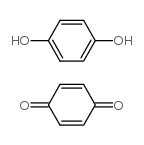醌氢醌

醌氢醌结构式

|
常用名 | 醌氢醌 | 英文名 | Quinhydrone |
|---|---|---|---|---|
| CAS号 | 106-34-3 | 分子量 | 218.20500 | |
| 密度 | 1.32 | 沸点 | 285 °C | |
| 分子式 | C12H10O4 | 熔点 | 167-172 °C(lit.) | |
| MSDS | 中文版 美版 | 闪点 | 141.6ºC | |
| 符号 |

GHS06 |
信号词 | Danger |
|
Tenebrionid secretions and a fungal benzoquinone oxidoreductase form competing components of an arms race between a host and pathogen.
Proc. Natl. Acad. Sci. U. S. A. 112 , E3651-60, (2015) Entomopathogenic fungi and their insect hosts represent a model system for examining invertebrate-pathogen coevolutionary selection processes. Here we report the characterization of competing components of an arms race consisting of insect protective antimicr... |
|
|
Positional adaptability in the design of mutation-resistant nonnucleoside HIV-1 reverse transcriptase inhibitors: a supramolecular perspective.
AIDS Res. Hum. Retroviruses 29(1) , 4-12, (2013) Drug resistance is a key cause of failed treatment of HIV infection. The efficacy of nonnucleoside reverse transcriptase-inhibiting (NNRTI) drugs is impaired by the rapid emergence of drug-resistant mutations. The literature supports the idea that purposefull... |
|
|
The effect of the hydrogen ion concentration upon the salt error of the quinhydrone electrode.
J. Am. Chem. Soc. 69(3) , 533-6, (1947)
|
|
|
[Not Available].
Z. Gesamte Inn. Med. 2(11-12) , 333-46, (1947)
|
|
|
A quinhydrone-type 2 ratio 1 acceptor-donor charge transfer complex obtained via a solvent-free reaction.
Chem. Commun. (Camb.) (16) , 1751-3, (2006) A 2 : 1 2-methoxybenzoquinone (BQ(OMe))-hydroquinone (H2Q) complex (5), obtained as single crystals by a solvent-free reaction, combines dipolar and pi-pi interactions, as well as hydrogen bonding. |
|
|
Disulfide bond formation involves a quinhydrone-type charge-transfer complex.
Proc. Natl. Acad. Sci. U. S. A. 100(24) , 13779-84, (2003) The chemistry of disulfide exchange in biological systems is well studied. However, the detailed mechanism of how oxidizing equivalents are derived to form disulfide bonds in proteins is not clear. In prokaryotic organisms, it is known that DsbB delivers oxid... |
|
|
Zinc-induced oxidative stress in Verbascum thapsus is caused by an accumulation of reactive oxygen species and quinhydrone in the cell wall.
Physiol. Plant. 140(3) , 209-24, (2010) Oxidative stress is one aspect of metal toxicity. Zinc, although unable to perform univalent oxido-reduction reactions, can induce the oxidative damage of cellular components and alter antioxidative systems. Verbascum thapsus L. plants that were grown hydropo... |
|
|
Studies on porphyrin-quinhydrone complexes: molecular recognition of quinone and hydroquinone in solution.
J. Org. Chem. 66(13) , 4601-9, (2001) Free-base and zinc(II) porphyrins bearing either one, two, or four hydroquinone entities at the meso positions are shown to bind quinones in solutions via a quinhydrone pairing mechanism. Electrochemical studies reveal that the quinhydrone complexes are stabi... |
|
|
The rH index for quality and environmental controls: standards and application procedures.
Ann. Chim. 91(3-4) , 117-26, (2001) The quantity rH, an index of the reducing power of a redox system is, in conceptual and operational terms, coordinatively linked with the two familiar electroanalytical quantities: redox potential (EO/R) and pH, and has recently become important in quality an... |
|
|
A computational study on the stacking interaction in quinhydrone.
J. Phys. Chem. A 111(10) , 1998-2001, (2007) The stability and electron density topology of quinhydrone complex was studied using multiple computational levels, including MPW1B95 Truhlar's density functional. The QTAIM analysis demonstrates that an electron population transfer from hydroquinone to quino... |